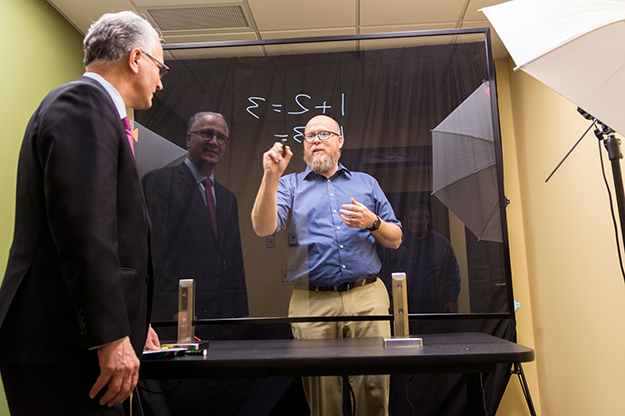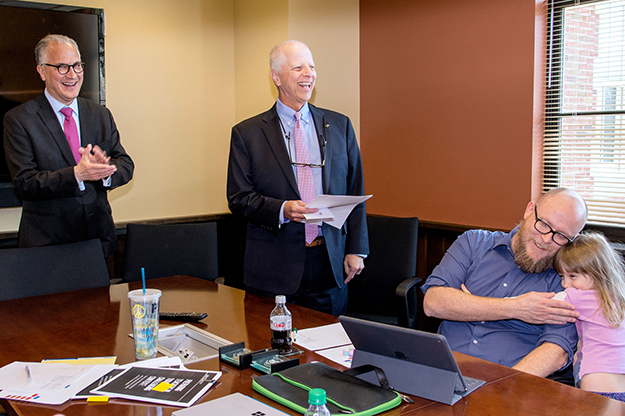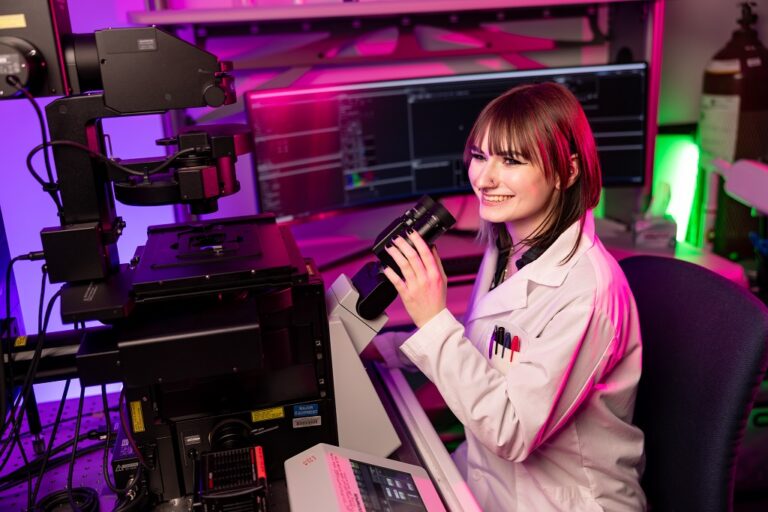New window on teaching
Education Professor Marcus Weaver-Hightower shows off his ‘lightboard’ studio, as latest recipient of NDUS award for technology in the classroom

A routine faculty meeting in UND’s Department of Educational Foundations and Research was interrupted with the arrival of two guests. President Mark Kennedy and Provost Tom DiLorenzo stopped in Tuesday, March 21, to surprise Marcus Weaver-Hightower with the North Dakota University System’s Commendatory Faculty Award.
The award recognizes faculty who have demonstrated innovative use of technology in delivering classroom instruction.
“Marcus has pioneered a number of innovations in using technology for instruction,” said DiLorenzo. “This hasn’t just been ‘bells and whistles’ for entertainment — he has worked to make knowledge and skills more accessible and engaging for students.”
“Accessible and engaging” are the words to describe Weaver-Hightower’s latest project: a “lightboard” studio in the Education Building. It is designed for creating presentations that more actively involve online students, who are an increasingly important component of the University.

Look-through experience
The traditional method of recording a presentation for online use has drawbacks. First, things written on whiteboards do not show up well on video and are difficult to read. Second, the instructor has his or her back to the viewer when using the whiteboard, something that is less involving to the viewer.
The lightboard studio, however, offers a “look-through” experience for the viewer. Its centerpiece is a large pane of tempered glass with LEDs (light-emitting diodes) embedded on the edges. The studio also includes lighting, microphones, video camera and computer.
“It’s the first one on campus, and as far as I know, it’s the only one in North Dakota,” Weaver-Hightower said. It was set up with UND technology fee funds.
Facing the video camera, an instructor stands behind the lightboard glass and can write directly on it with whiteboard “neon” markers. A black background behind the instructor makes the writing stand out. When the lightboard’s LEDs interact with the writing, “it literally glows,” he remarked.
“Instructors can record videos and mirror the image in the computer so that the writing isn’t backwards,” he continued. “We also have equipment that can flip the video in real time for live online courses, or even hybrid classes with some students in the room and others online.
“This technology,” Weaver-Hightower said, “helps with a fundamental issue of instruction: engaging students and holding their attention by being able to look at them and use gestures and facial expressions, all while writing on the board at the same time. Sounds simple, but for online students, every chance we can seize to provide personal engagement helps them feel more connected.”
The initial use of the lightboard studio has been mainly within the department and College of Education and Human Development, but any discipline could use it.
“Anyone who wants to write things on the board or draw a diagram could benefit,” Weaver-Hightower said. “In medicine, they might want to draw a diagram of how a cancer cell operates.
“One of the nice things,” he continued, “is that you can project PowerPoint slides on to the screen. For an art history class, for example, you could project a great work of art and draw circles around important parts of it.”
Simplicity for the instructor is important, Weaver-Hightower pointed out: “We use some really simple stuff, like iMovie, which basically every Mac ships with. I want to get it so much simpler, so that someone can walk in, close the door, pull down the shade on the window, flip one switch, and the whole setup comes on — so that the technology part gets out of the way.”
Educating for and with technology
The application of technology toward educational goals has long fascinated Weaver-Hightower.
“Ever since I was getting my bachelor’s degree at Winthrop University in South Carolina, I’ve been trying out ways to bring the computer into education to make it a useful tool for students,” he said. “When I was a high school teacher back in the mid-1990s, I was teaching students how to make simple Web pages. I was trying to get students to do it themselves — not necessarily to be consumers of what’s on the Internet, but also to be producers.”
At UND, Weaver-Hightower still encourages his graduate students to be producers of digital content, such as making wikis and websites about key educational issues.
Weaver-Hightower has gained wide attention and appreciation for his expertise in technology. His visually rich slide shows are famous among students who have taken his classes. His strong interest in popular culture adds, although he admits, “It’s harder and harder to stay ‘hip’ and ‘with it.’ But I do try to inject some humor into things, and technology helps me do that.”
Weaver-Hightower’s instructional videos have been seen by students around the globe. His video on pecha kuchas (Japanese for “chitchat”) has been viewed more than 158,000 times on YouTube. This is a tight format in which 20 slides stay up for 20 seconds each, so the presentation is done in seven minutes. He also has produced a series of videos on tips for writing that have drawn wide viewership.
Profile:
Marcus Weaver-Hightower is a professor of educational foundations and research, and chair of the department. He received his Ph.D. in curriculum and instruction from the University of Wisconsin, Madison. He teaches graduate courses in gender and education, the sociology of education, and qualitative research. His research interests include the politics of boys’ education, masculinity studies, the politics of food, literacy studies, and the use of comics and graphic novels in qualitative research and classrooms.


